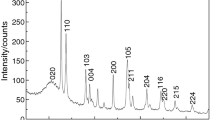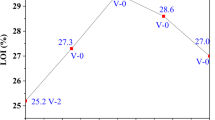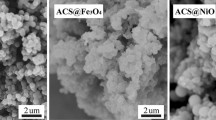Abstract
Nanoscale and cubic-shaped FeSnO(OH)5 (ITOH) flame retardant was synthesized by co-precipitation method and characterized by X-ray diffraction and transmission electron microscopy (TEM). The blank poly(vinyl chloride) (PVC0) and flexible PVC/ITOH composites were investigated by the limiting oxygen index (LOI), cone calorimetric test, tensile test and thermogravimetric analysis. The results showed that compared with PVC0, the LOI of PVC sample treated with 15 phr ITOH (PVC15) increases by 7.7%, and ITOH could more effectively promote the dehydrochlorination reaction of PVC. The flame of PVC15 disappeared for up to 165 s when it burned for 120 s, which significantly reduced the total heat release and total smoke production of PVC. This phenomenon not only can effectively prevent the proliferation of fire, but also facilitates the evacuation of people in the event of a fire. Lewis acid FeCl2 and FeOCl, assigned by the Fe2p spectra of char residue, could effectively catalyze the cross-linking of PVC into carbon.













Similar content being viewed by others
References
Jia P, Zhang M, Hu L, Feng G, Zhou Y. Synthesis of novel caged phosphate esters and their flame retardant effect on poly(vinyl chloride) blends. Chem Lett. 2015;44(9):1220–2.
Carroll WF, Johnson RW, Moore SS, Paradis RA (2017) 4–Poly(vinyl chloride). In: Kutz M, editor. Applied plastics engineering handbook, 2nd ed. The Vinyl Institute, Alexandria, VA: Matthew Deans; 2017. p. 73–89.
Sun YJ, Gao M, Chai ZH, Wang H. Thermal behavior of the flexible polyvinyl chloride including montmorillonite modified with iron oxide as flame retardant. J Therm Anal Calorim. 2018;131:65–70.
Ou YX, Chen Y, Wang XM. Flame-retarded polymeric materials. Beijing: National Defense Industry Press; 2001. p. 16–9.
Liu X, Wang JY, Yang XM, Wang YL, Hao JW. Application of TG/FTIR TG/MS and cone calorimetry to understand flame retardancy and catalytic charring mechanism of boron phosphate in flame-retardant PUR-PIR foams. J Therm Anal Calorim. 2017;130:1817–27.
Jiao YH, Wang X, Peng F, Xu JZ, Gao JG, Meng HJ. Increased flame retardant, smoke suppressant and mechanical properties of semi-rigid polyvinyl chloride (PVC) treated with zinc hydroxystannate coated dendritic fibrillar calcium carbonate. J Macromol Sci B. 2014;53(3):541–54.
Klapiszewski L, Tomaszewska J, Skórczewska K, Jesionowski T. Preparation and characterization of eco-friendly Mg(OH)2 lignin hybrid material and its use as a functional filler for poly(vinyl chloride). Polymers. 2017;9(7):258.
Zhang ZF, Wu WH, Zhang MJ, Qu JM, Shi L, Qu HQ, et al. Hydrothermal synthesis of 4ZnO center dot B2O3 center dot H2O/RGO hybrid material and its flame retardant behavior in flexible PVC and magnesium hydroxide composites. Appl Surf Sci. 2017;425:896–904.
Basfar AA. Flame retardancy of radiation cross-linked poly(vinyl chloride) (PVC) used as an insulating material for wire and cable. Polym Degrad Stab. 2002;77(2):221–6.
Schartel B, Kunze R, Neubert D, Tidjani A. ZnS as fire retardant in plasticised PVC. Polym Int. 2002;51(3):213–22.
Sang B, Li Z, Yu L, Li X, Zhang Z. Preparation of zinc hydroxystannate-titanate nanotube flame retardant and evaluation its smoke suppression efficiency for flexible polyvinyl chloride matrix. Mater Lett. 2017;204:133–7.
Zhang B, Han J. Morphology control of zinc hydroxystannate microcapsules by sol-gel method and their enhanced flame retardancy properties for polyvinyl chloride composites. J Sol–Gel Sci Technol. 2017;81(2):442–51.
Zhang B, Liu H, Han J. Zinc hydroxystannate microencapsulated to improve its safety and application to flame-retardant, smoke-suppressed polyvinyl chloride composites. J Alloys Compd. 2017;712:768–80.
Yang G, Wu WH, Dong HX, Wang YH, Qu HQ, Xu JZ. Synergistic flame-retardant effects of aluminum phosphate and trimer in ethylene–vinyl acetate composites. J Therm Anal Calorim. 2018;132:919–26.
Kicko-Walczak E. Study on flame retardant unsaturated polyester resins-an overview of past and new developments. Polimery. 1999;44(11–12):724–9.
Xu JZ, Zhang CY, Qu HQ, et al. Zinc hydroxys-tannate and zinc stannate as flame retardant agents for flexible PVC. J Appl Polym Sci. 2005;98:1469–75.
Sun YJ, Gao M, Chai ZH, Wang H. Thermal behavior of the flexible polyvinyl chloride including montmorillonite modified with iron oxide as flame retardant. J Therm Anal Calorim. 2017;131:65–70.
Kissinger HE. Reaction kinetics in differential thermal analysis. Anal Chem. 1957;29:1702–6.
Akahira T, Sunose T. Method of determining activation deterioration constant of electrical insulating materials. Res Rep Chiba Inst Technol (Sci Technol). 1971;16:22–31.
Ozawa T. A new method of analyzing thermogravimetric data. Bull Chem Soc Jpn. 1965;38:1881–6.
Flynn JH, Wall LA. A quick, direct method for the determination of activation energy from thermogravimetric data. J Polym Sci B Polym Phys. 1966;4:323–8.
Nakayama N, Kosuge K, Kachi S, Shinjo T, Takada T. Magnetic properties of FeSn(OH)6 and its oxidation product FeSnO(OH)5. Mater Res Bull. 1978;13(1):17–22.
Welch MD, Kampf AR. Stoichiometric partially-protonated states in hydroxide perovskites: the jeanbandyite enigma revisited. Miner Mag. 2017;81(2):297–303.
Huanga D, Fuac X, Longc J, Jianga X, Changa L, Menga S, et al. Hydrothermal synthesis of MSn(OH)6 (M = Co, Cu, Fe, Mg, Mn, Zn) and their photocatalytic activity for the destruction of gaseous benzene. Chem Eng J. 2015;269:168–79.
Selvi J, Mahalakshmi S, Parthasarathy V. Synthesis, structural, optical, electrical and thermal studies of poly(vinyl alcohol)/CdO nanocomposite films. J Inorg Organomet Polym Mater. 2017;27(6):1918–26.
Qi YX, Wu WH, Han LJ, Qu HQ, Han X, Wang AQ, et al. Using TG-FTIR and XPS to understand thermal degradation and flame-retardant mechanism of flexible poly(vinyl chloride) filled with metallic ferrites. J Therm Anal Calorim. 2015;123(2):1263–71.
Xu JZ, Jiao YH, Zhang B, Qu HQ, Yang GZ. Tin dioxide coated calcium carbonate as flame retardant for semirigid poly(vinyl chloride). J Appl Polym Sci. 2006;101(1):731–8.
Qu HQ, Wu WH, Wei HY, Xu JZ. Metal hydroxystannates as flame retardants and smoke suppressants for semirigid poly(vinyl chloride). J Vinyl Addit Technol. 2008;14(2):84–90.
Subasinghe A, Das R, Bhattacharyya D. Parametric analysis of flammability performance of polypropylene/kenaf composites. J Mater Sci. 2016;51(4):2101–11.
Herzler J, Roth P. Shock tube study of the reaction of H atoms with SnCl4. ChemInform. 2002;21:5259–64.
Li ZW, Shao B, Huang YS, Li XH, Zhang ZJ. Effect of core-shell zinc hydroxystannate nanoparticle-organic macromolecule composite flame retardant prepared by masterbatch method on flame-retardant behavior and mechanical properties of flexible poly(vinyl chloride). Polym Eng Sci. 2014;54(9):1983–9.
Author information
Authors and Affiliations
Corresponding author
Additional information
Publisher's Note
Springer Nature remains neutral with regard to jurisdictional claims in published maps and institutional affiliations.
Rights and permissions
About this article
Cite this article
Zhao, H., Wu, J., Hu, WD. et al. The block combustion, high char residues and smoke restrain effect of nano-FeSnO(OH)5 on polyvinyl chloride. J Therm Anal Calorim 137, 1255–1265 (2019). https://doi.org/10.1007/s10973-019-08054-6
Received:
Accepted:
Published:
Issue Date:
DOI: https://doi.org/10.1007/s10973-019-08054-6




